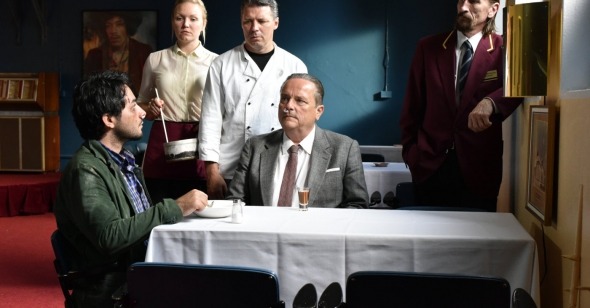State of the Art
By Giovanni Vimercati
The Other Side of Hope
Dir. Aki Kaurismäki, Finland, Janus Films
Hardly fashionable traits among cinephiles, human empathy and solidarity have constituted the poetic and political backbone of Aki Kaurismäki’s cinema since his 1981 debut Crime and Punishment, a counterintuitive reinterpretation of Dostoyevsky’s classic. Throughout his career he has chronicled life on the margins to find beauty where others only see barren squalor. Rather than a rhetorical stance, his commitment to lost causes stems from a genuine contempt for conformism, while the anti-naturalism of his dramaturgy abstains from sentimentalism and emotional manipulation. Generous and witty, Kaurismäki’s films offer dignity to those who couldn’t afford it, making the comfortable feel uncomfortable and vice versa. In The Other Side of Hope, the Finnish director manages to find grace amidst disgrace, relieving the so-called refugee crisis (read: the violent displacement of innocent people by postcolonial powers) from the hypocrisy with which it has been represented, onscreen (as in Rosi’s Fire at Sea, with its opportunistic use of migrants) and off. Those looking for an edifying tale on the nobility of charity will be sorely disappointed, for the only acts of fraternal unity in the film take place where respectable people wouldn’t dare venture. Kaurismäki is not afraid to depict the desolation and aridity of the human condition. Dedicated to a cinematic emblem of radical humanism, the late Peter Von Bagh, The Other Side of Hope is a slapstick tragedy playing out in slow motion against the shameful backdrop of the biggest political crime of our times: the gratuitous and outright persecution of people guilty of being born in the wrong corner of the world.
Kaurismäki’s previous film took its name from France’s town of Le Havre, one of the many postindustrial cul-de-sacs where European capitalism rusts in peace. Another port city hosts his latest attempt to deliver moving images from the clutches of irrelevance, artistic and otherwise. The film’s protagonist, Khaled (Sherwan Haji), arrives in Helsinki, Finland, covered in coal after Polish fascists in Gdańsk have beaten him up and chucked him on a cargo ship. He has fled Syria after his hometown of Aleppo turned into a proxy war where unscrupulous global and regional powers competed for geopolitical influence like a pack of rabid dogs. Along the tortuous way he has lost contact with his sister, one of his few surviving family members. This is a drama that the xenophobic bureaucracy of Europe cannot possibly comprehend, let alone sympathize with, as Khaled is denied political asylum and forced into “illegality.” There is no substantial difference between the walls of the detention center and the less than friendly streets of Helsinki, and it’s only outside the law that Khaled will find a modicum of comfort and solidarity.
His misadventures are paralleled by those of another lonely wanderer, Wikström (Sakari Kuosmanen), a newly divorced salesman who decides to open a restaurant. Their chance encounter will inaugurate a new chapter in the precarious life of the Syrian refugee, who will find in Wikström’s restaurant a job, a shelter from fascist thugs, and a new, forged identity. Thanks to the impassive yet unfeigned generosity of his new boss and colleagues, our hero will even reunite with his sister just in time for an unhappy ending. As always with Kaurismäki, the only flashes of aesthetic redemption are to be found in society’s dustier nooks. The anachronism of a film in which people still write on typewriters and use archaic landline phones evokes a remote allegorical dimension onto which the present is negatively reflected. There is no vintage nostalgia in the world Kaurismäki conjures in The Other Side of Hope though, as even the old jukebox and rock ‘n’ roll tunes are the symbols of a timeless romance, maintaining their original spirit of defiance. While as humans we may have collectively failed, the director seems to suggest, moments of selfless dignity can still be experienced by those who refuse to comply.
The director implacably frames the sad and dangerous state of a Westernsociety able to digest diversity only through ethnic restaurants, such as the ironic restyling of Wikström’s restaurant as a sushi establishment serving canned herrings buried under wasabi paste, only to be turned into an Indian eatery a week later. Though he never renounces his dry wit, there is no mistaking Kaurismäki’s deadly serious intentions regarding what he has called “the biggest shame in Europe right now.” If his latest film does not feel like his freshest and most original, it still stands as one of the very few, if not the best film made on this subject. Without giving any political or historical context, The Other Side of Hope lucidly exposes the absurdity of a humanitarian catastrophe systematically treated in the press and by politiciansas some sort of natural disaster. “With this film I try my best to break the European point of view on refugees,” the Finnish director stated. “The creation and development of our prejudices and stereotypes has a dark and sinister resonance in the history of Europe.”
Less whimsical than Le Havre, this is by far his most overtly political work, a choice one suspects was dictated more by the deteriorating situation in Europe than a lack of better or more “sophisticated” ideas. Even the chromatic palette veers into darker tonalities compared to the previous film, which retained the colors of a fairy tale. For a film director to acknowledge the truths of our social condition over the privileges of fiction is something to celebrate, especially these days, when cinema itself seems to be the only point of reference for anyone making movies. Though his characters may not be known for their psychological depth or narrative complexity, Kaurismäki has the ability to sketch the essential traits of humanity without indulging in superfluous existentialism, reminding us that exceptional works of art can be molded from the ruins of our desperate reality.
